As a business school, not only is it imperative that you use the right platforms to reach the right audience, but it’s also crucial that you present a cohesive brand identity to prospective students. With about a billion users in over 200 countries, LinkedIn is considered a powerhouse for networking in the business world. Those interested in pursuing a business education will likely be active on this platform. How can you determine what your target audience wants to see from you on LinkedIn? How should you use the platform to build a strong presence as a business school? What are some best practices when implementing content marketing for business schools?
Over the years, we’ve observed how LinkedIn works and what business schools need to reach the right users. Let’s explore the characteristics of a business school brand that would perform well on LinkedIn and how you can use the unique benefits of this massive platform to present your unique selling points to future students. Discover LinkedIn’s features, what its algorithm likes, and how to tailor your business school content marketing strategy accordingly. By the end, you’ll be well-equipped with the tools to strengthen your online presence as a business school and increase your enrollment.
Why A Strong LinkedIn Presence Matters For Business Schools
Regarding content marketing for business schools, a strong LinkedIn presence will enable you to connect with a vast network of professionals, alumni, and prospective students, increasing prospective students’ engagement and eventually boosting your enrollment. LinkedIn is where future business professionals scope out industry trends, carve out their niche, and create personal brands that appeal to prospective employers and clients. Regular activity and engagement on LinkedIn will enhance your school’s visibility and help you reach the right audience. You can access detailed demographic data through LinkedIn Ad Targeting to inform your strategy. While most self-reported data from social media users raises concerns about accuracy, LinkedIn is different.
Because users are incentivized to provide high-quality information to be found by potential employers and clients, when targeting the ideal audience for your business school, you can rest assured that the data likely holds. LinkedIn’s advanced targeting capabilities, using information such as job title, company, industry, and seniority, allow you to create data-driven content marketing campaigns. What is a successful content strategy for business schools looking to grow their presence on LinkedIn? Let’s explore.
Ready to explore the potential of LinkedIn for your business school? Let us guide you through its benefits and show you how to attract new prospects effectively. Explore our tailored services today!
Exploring The Platform: How The LinkedIn Algorithm Works
To find and reach your target audience on LinkedIn, you must understand how the algorithm works. Algorithms serve as a filter on platforms where copious amounts of content are constantly being created and shared. Quality content is identified and distributed to the audience whose interests best align with the subject matter based on their disclosed demographic data. Here’s how the LinkedIn algorithm works and what you can do to reach the right users.
The LinkedIn algorithm begins by classifying your post to determine whether it violates the platform’s spam guidelines or other community policies. AI detects clear violations and filters content accordingly. Some examples of spam defined by LinkedIn are emojis or reaction polls designed to boost engagement artificially, Chain letters, and Requests for likes, reactions, and shares. The LinkedIn algorithm doesn’t like excessive, irrelevant, or repetitive comments or messages.
For some content, the filtering process could be more transparent and dry. When AI fails to analyze and categorize your content on LinkedIn, a human review occurs where a content expert determines whether your content provides value for users. If the reviewer finds your content free of spam or excessive fluff, it will be put to the test. Your content is shown to your immediate followers, and based on the post’s engagement, the algorithm decides whether it might resonate with a broader audience. Next, LinkedIn distributes content Using three ranking signals (content, identity, and member activity). Check out a visual representation of how the LinkedIn algorithm works to feed relevant content to those who want to see it.
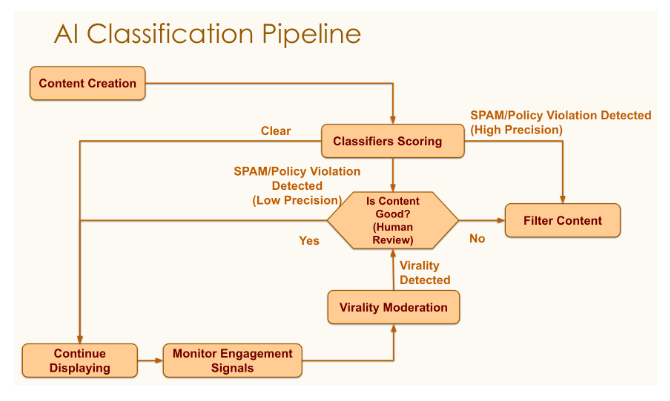
Source: LinkedIn Engineering Blog
With this information in mind, how can you create an effective business school marketing strategy that drives results? Remember these tips:
Start By Establishing Your Mission
A clearly defined mission helps align the content with your core values and educational objectives, ensuring that all marketing efforts align with your school’s unique brand. This way, you create a consistent brand identity, essential in differentiating the school in a competitive academic landscape. Remember, there are over 133,000 schools listed on LinkedIn. Think of how your mission will help you to stand out.
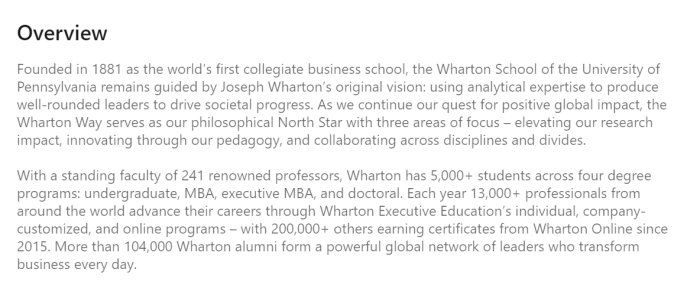
Source: LinkedIn
Example: Wharton Business School clearly states its vision in its LinkedIn overview. In a marketing landscape where users want to get to the meat of the matter rather quickly, this is an example of a clear, cohesive brand easily palatable to those exploring LinkedIn.
Get To Know Your Target Audience
As a business school, you need to understand your prospective students. Using LinkedIn’s robust data analytics capabilities combined with your human instincts, you can glean many valuable insights about your prospective student’s career aspirations, educational needs, and personalities.
By using a marketing method called social listening, which involves closely monitoring the discussions and trends within relevant groups, you can better understand potential students. You can identify influencers in the business space who can offer deeper insights into your target audience and collaborate with them on content.
Developing targeted student personas is crucial for a business school to create an effective marketing strategy. These personas represent fictional, generalized characters that embody the traits of key segments of their target audience. The process of making them involves data collection, demographic analysis, including psychographic information based on the data you’ve collected, identifying pain points and concerns, including details about the prospective student’s career goals, adding real stories and quotes where applicable, and continuing to refine the personas as you find additional information.
Student personas should be central to your marketing strategy. LinkedIn content should always be tailored to their unique sensibilities to increase value, engagement, and conversions. Look at the dashboard below for the many filters you can use to find your ideal student.
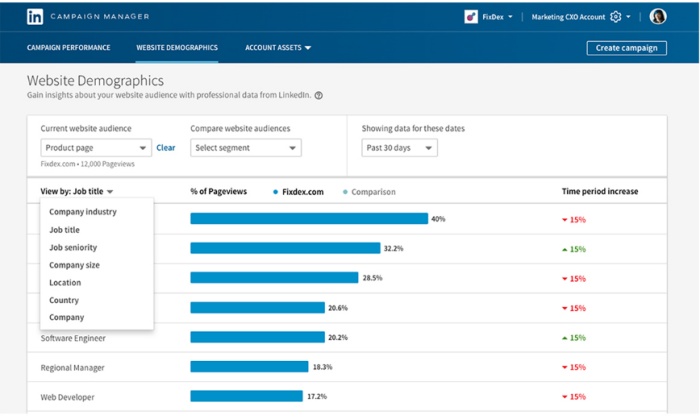
Source: LinkedIn
Refine Your Strategy With Clear, Measurable Goals
Once you’ve determined a vital mission for your business school brand, it’s time to define actionable objectives that can be measured, assessed, and adjusted over time. Start your goal setting by identifying your key performance indicators (KPIs) and determining your current position on LinkedIn. Using LinkedIn Analytics, you can uncover valuable data such as the conversion rate, follower growth rate, engagement rate, impressions, and click-through rate (CTR).
Become A Thought Leader In The Business School Space
Becoming a thought leader is a highly effective business school marketing strategy that works by establishing trust and credibility with prospective students. Prospective students engaging with content created by thought leaders get the sense that they’ve received valuable information that will help them reach their career aspirations, thus attracting them to your brand.
LinkedIn is an effective platform for distributing content such as articles, case studies, and news about the school, reaching a broad and relevant audience. Don’t miss the opportunity to carve out your school’s niche in the business world and gain recognition as an expert voice.
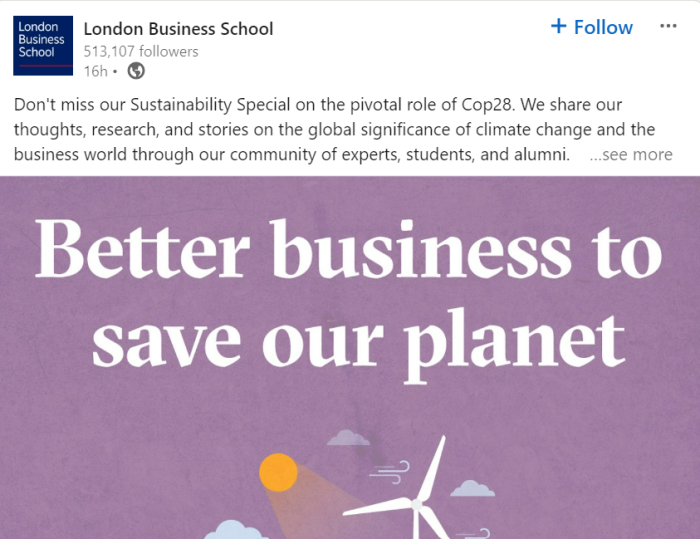
Source: LinkedIn
Example: Top institution, London Business School, regularly posts fresh, engaging content that highlights new trends and developments in the industry. The post above addresses a timely, relevant topic that would appeal to those looking to enter the business profession. It catches the eye with a compelling feature image and promises value by leading to insights from reputable field experts.
Showcase Your School Community
To resonate with prospective students on a profound level, business schools must humanize their brand on social media. Engaging your alumni is a great way to accomplish this. How do you leverage an alumni network? LinkedIn provides a platform for schools to engage with their alumni, sharing success stories and updates, which can aid a variety of opportunities like fundraising, networking, and, of course, boosting enrollment. In content, use real stories, images of real people, and a warm tone that showcases your school’s relationship with members of its community.
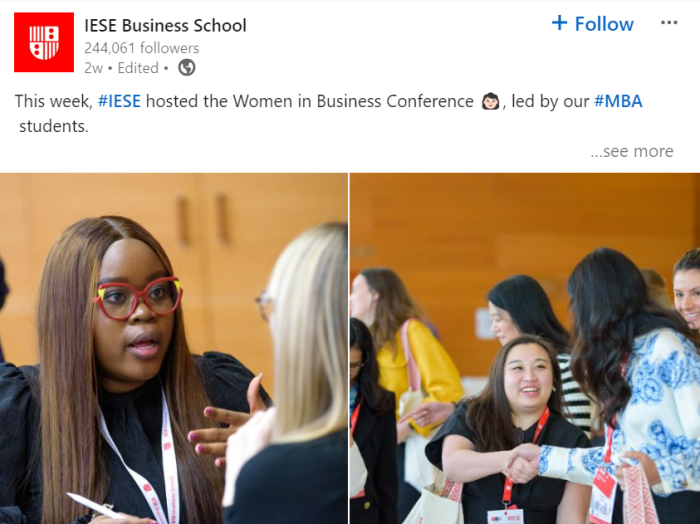
Source: LinkedIn
Example: On their LinkedIn page, as a top business school, IESE regularly uplifts outstanding student body members. Their posts highlight the dynamic learning experience that they provide. This post likely stores excitement in prospective business students who want to be a part of a dynamic community of fellow learners.
Content Marketing For Business Schools: Best Practices To Remember
Now that you know what it takes to do well on the LinkedIn algorithm, it’s time to start the creative process! What does effective business school marketing content look like? Let’s explore some essential best practices to help you craft and share content that resonates with your target audience and converts.
Industry insights, academic achievements, student and alumni success stories, and faculty research perform very well on LinkedIn. Start creating your content calendars by continually referring to the detailed, targeted student personas you created in the planning stage of your content marketing strategy.
Before creating content to connect with your target audience, ensure you’ve optimized your LinkedIn profile page. It should be complete and up-to-date, with a clear description, contact information, and a link to the school’s website. Use keywords relevant to business education in the bio, and be sure to include compelling visuals to capture the attention of LinkedIn users.
When developing business school marketing ideas for content, it’s crucial to evaluate the format that each platform prefers. On LinkedIn, high-quality video and image-based posts catch the attention of users very effectively and offer a unique opportunity for you to share campus tours, event highlights, and highlight reputable guest speakers. To further develop your school’s status as a thought leader, utilize LinkedIn’s publishing platform for longer content like articles and newsletters. This promotes consistent sharing, significantly increases engagement, and cements your school as a professional institution with valuable information to share.
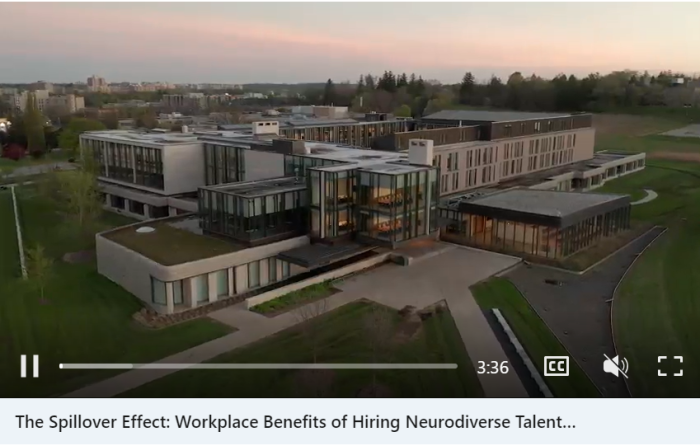
Source: LinkedIn
Example: At the beginning of their LinkedIn video posts, Ivey Business School often displays cinematic shots of its impressive campus. Their eye-catching campus is a visually appealing backdrop for their valuable faculty presentations.
To further boost your visibility, try using your content to promote courses on LinkedIn Learning. LinkedIn Learning is a vast online learning platform that provides video-based courses taught by experts from a variety of fields. This can position your business school as a leader in professional development and prompt the algorithm to distribute your content to a wider audience. Engaging actively with your audience is another highly effective way to ensure that the LinkedIn algorithm recognizes your business school as a source of valuable content. By responding to comments, participating actively in discussions, participating in LinkedIn Groups, and encouraging interaction using relevant polls and questions, you can significantly increase your school’s visibility and establish yourself as an active contributor to the business world.
To drive results in your business school marketing strategy, ensure that data remains central to your content development. Using LinkedIn Analytics, regularly review data to understand what type of content performs best and adapt accordingly.
LinkedIn is a very valuable tool for business schools to learn more about their target audience, share content, and curate a highly compelling brand; however, it should represent one part of your content marketing strategy. Using inbound marketing principles, your business school should leverage several platforms and content types to reach prospective students. Let’s delve into inbound marketing and what it looks like when used correctly.
LinkedIn Is Part Of An Inbound Marketing Plan That Converts
Using inbound marketing principles, you can reach the right prospective students at the right time, drive quality traffic to your school site, and increase conversions. What is inbound marketing?
Inbound marketing is a strategy that focuses on attracting customers through relevant and helpful content and interactions, rather than traditional outbound marketing tactics like advertising, cold calls, and emails. Inbound marketing is a cost-effective strategy on account of the fact that it aims to target audiences that are already interested in your offers. Key elements of inbound marketing include the following:
Attract
This phase involves creating and sharing content tailored to your target audience’s interests and needs. The goal is to attract potential students to your brand through engaging content such as blog posts, social media updates, search engine optimization (SEO), visual content, and informative newsletters.
To increase your business school’s visibility using LinkedIn, be sure to identify your target, create detailed student personas based on thorough demographic research, optimize your LinkedIn content in a way that reflects the specific sensibilities of your audience, and use LinkedIn Analytics to continually adjust content according to the users in the business education space.
Engage
Once potential customers are attracted to your brand, the next step is to engage with them by providing solutions to their problems and answers to their questions. This can be achieved through targeted communications, interactive tools, and offering valuable resources, all aimed at building a relationship.
We’ve explored the value of responding to your LinkedIn comments, participating in LinkedIn groups, and participating in relevant discussions within the business field on the platform. This active engagement is an excellent way to humanize your school’s brand while boosting your visibility and having your content widely distributed through the algorithm.
Delight
The final phase focuses on providing an outstanding experience that satisfies potential students and turns them into brand advocates when they graduate. This involves, first and foremost, providing an unparalleled learning experience, offering personalized interactions and ongoing support.
On LinkedIn, you can delight prospective students by offering expert advice to those who want to enter the business world and answering their questions. You can also promote relevant LinkedIn Learning courses to help potential students achieve their goals before they begin training with you. How do I network my school alumni on LinkedIn? Put your educational value on display in your content, and whenever possible, get your alumni community to validate how you’ve enriched their educational experience and career journeys.
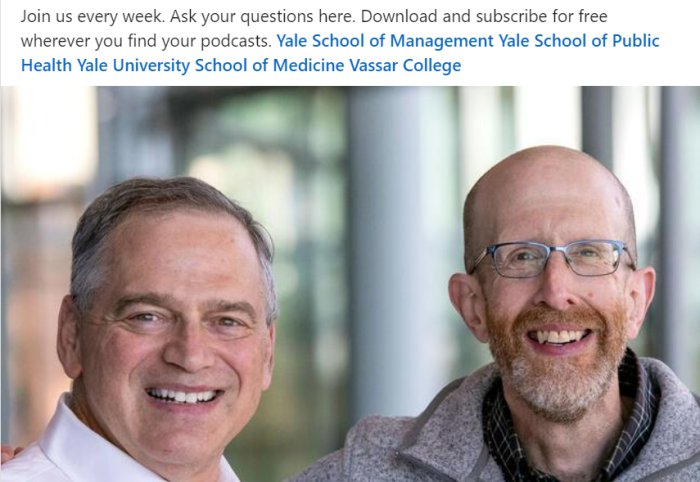
Example: On the Yale School Of Management LinkedIn page, Professor Howard Forman regularly promotes his free podcast called Health and Veritas, where he interviews colleagues and provides listeners with high-quality insights on a variety of business topics such as leadership, social entrepreneurship, global business, and much more. The business student community can even ask questions related to the field, driving great engagement. Sharing expert, thought-provoking content is a highly effective way to delight LinkedIn users – especially when it’s free.
Harnessing LinkedIn’s potential as a powerful platform for content marketing is essential for business schools aiming to enhance their online presence and attract prospective students. By understanding and adeptly navigating LinkedIn’s algorithm, establishing a clear and compelling mission, and developing a deep understanding of your target audience, you can create content that resonates with prospective students and positions your institution as a thought leader in the business education space.
By doing so, you’ll increase your school’s visibility and appeal to prospective students and build a vibrant, engaged community around your brand. As the landscape of LinkedIn marketing for business schools continues to evolve, staying agile and responsive to these changes will be crucial to your success. A little help can go a long way. Digital marketing strategy for schools is what we do. With plenty of experience providing a wide range of content marketing services to business schools, we can help you build your LinkedIn presence and work strategically toward a wide range of marketing objectives.







